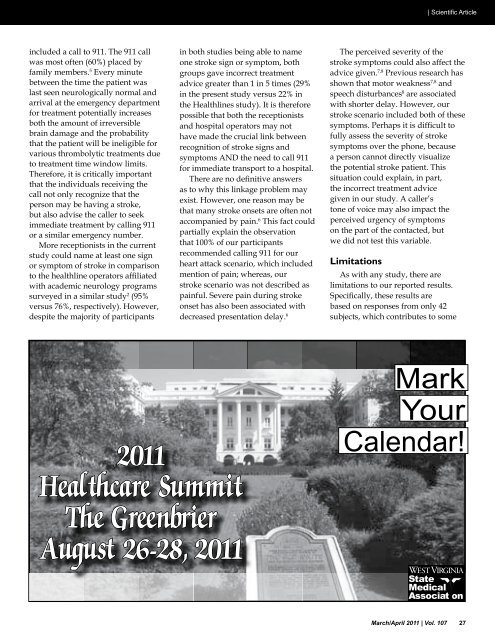March/April - West Virginia State Medical Association
March/April - West Virginia State Medical Association
March/April - West Virginia State Medical Association
You also want an ePaper? Increase the reach of your titles
YUMPU automatically turns print PDFs into web optimized ePapers that Google loves.
| Scientific Article<br />
included a call to 911. The 911 call<br />
was most often (60%) placed by<br />
family members. 5 Every minute<br />
between the time the patient was<br />
last seen neurologically normal and<br />
arrival at the emergency department<br />
for treatment potentially increases<br />
both the amount of irreversible<br />
brain damage and the probability<br />
that the patient will be ineligible for<br />
various thrombolytic treatments due<br />
to treatment time window limits.<br />
Therefore, it is critically important<br />
that the individuals receiving the<br />
call not only recognize that the<br />
person may be having a stroke,<br />
but also advise the caller to seek<br />
immediate treatment by calling 911<br />
or a similar emergency number.<br />
More receptionists in the current<br />
study could name at least one sign<br />
or symptom of stroke in comparison<br />
to the healthline operators affiliated<br />
with academic neurology programs<br />
surveyed in a similar study 2 (95%<br />
versus 76%, respectively). However,<br />
despite the majority of participants<br />
in both studies being able to name<br />
one stroke sign or symptom, both<br />
groups gave incorrect treatment<br />
advice greater than 1 in 5 times (29%<br />
in the present study versus 22% in<br />
the Healthlines study). It is therefore<br />
possible that both the receptionists<br />
and hospital operators may not<br />
have made the crucial link between<br />
recognition of stroke signs and<br />
symptoms AND the need to call 911<br />
for immediate transport to a hospital.<br />
There are no definitive answers<br />
as to why this linkage problem may<br />
exist. However, one reason may be<br />
that many stroke onsets are often not<br />
accompanied by pain. 6 This fact could<br />
partially explain the observation<br />
that 100% of our participants<br />
recommended calling 911 for our<br />
heart attack scenario, which included<br />
mention of pain; whereas, our<br />
stroke scenario was not described as<br />
painful. Severe pain during stroke<br />
onset has also been associated with<br />
decreased presentation delay. 6<br />
The perceived severity of the<br />
stroke symptoms could also affect the<br />
advice given. 7,8 Previous research has<br />
shown that motor weakness 7,8 and<br />
speech disturbances 8 are associated<br />
with shorter delay. However, our<br />
stroke scenario included both of these<br />
symptoms. Perhaps it is difficult to<br />
fully assess the severity of stroke<br />
symptoms over the phone, because<br />
a person cannot directly visualize<br />
the potential stroke patient. This<br />
situation could explain, in part,<br />
the incorrect treatment advice<br />
given in our study. A caller’s<br />
tone of voice may also impact the<br />
perceived urgency of symptoms<br />
on the part of the contacted, but<br />
we did not test this variable.<br />
Limitations<br />
As with any study, there are<br />
limitations to our reported results.<br />
Specifically, these results are<br />
based on responses from only 42<br />
subjects, which contributes to some<br />
2011<br />
Healthcare Summit<br />
The Greenbrier<br />
August 26-28, 2011<br />
Mark<br />
Your<br />
Calendar!<br />
<strong>March</strong>/<strong>April</strong> 2011 | Vol. 107 27















